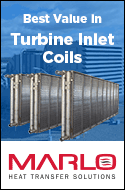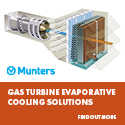FAQS
Wet Compression
Q1: What is the difference between fogging, over spraying, high fogging and wet compression?
A1: 1) Fogging is used to for evaporative cool the air to within 1°F of the wet-bulb temperature which corresponds to about 95% Relative Humidity.
2) Over spray was the practice of using a fogging system to oversaturate the inlet air; this has traditionally caused larger droplets to enter the compressor causing harm to the compressor.
3) High fogging was a term used by a gas turbine manufacturer installing wet compression.
4) Wet compression is the practice of a specifically designed system to introduce small particles of water inter near the compression section of a gas turbine, for cooling the air to the wet-bulb temperature (cannot achieve it unless there is fogging system upstream of the wet compression system), increasing the mass flow into the compressor and creating an inter-stage cooling effect during compression.
Q2: What type of water is used?
A2: Demineralized water is preferred to prevent suspended solids from plating out in the compressor and causing loss of efficiency or air cooling achieved.
Q3: Does the addition of wet compression increase the maintenance of my gas turbine?
A3: A properly installed system will not increase the maintenance of your gas turbine.
Q4: Can I control how much power I get?
A4: Yes. The newest systems use a variable frequency drive which allows one to change the amount of fog mass being introduced thus controlling the power increase. The limiting factors are set up with the initial design.
Q5: How long must my gas turbine be down to install wet compression?
A5: The common plant outage time of 3 to 5 days of outage is common outage time is adequate for installing a wet compression system.
Q6: What pressure does a wet compression system operate at?
A6:Optimal designed systems use a variable frequency drive to vary the pressure to pinless nozzles. Systems are normally operated at pressures between 400 and 2000 PSIG. Higher pressure systems require fewer number of nozzles.
Q7: How much power is used for wet compression?
A7: The newest technology systems use waffle plate multiple piston pumps that require between 1.4 and 1.9 horsepower per gallon per minute of water at a pressure of 2300 PSIG.
Q8: What kind of coating system is used to protect from corrosion in a wet compression system?
A8: An epoxy coating system that is suitable for water-submerged service is okay for wet compression systems.
Q9: Can I use wet compression with my chiller, evaporative media or fogging system?
A9: Yes, provided those systems are the installed system upstream and has has produce an exit air temperature of less than 50°F in order to prevent ice formation in the compressor.
Q10: How often do I have to change wet compression nozzles?
A10: With good filters and proper filter changes, nozzles will last upwards of 40,000 operating hours.




